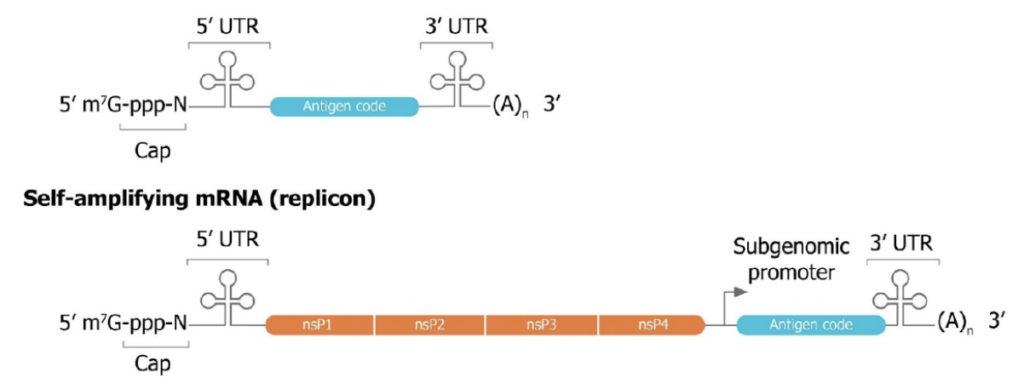San Diego-based startup company, Replicate Bioscience, announced on Tuesday, September 12, 2023, that it had begun its first clinical trial on an experimental rabies vaccine using self-amplifying mRNA (saRNA).
Figure 1 compares the structures of traditional mRNA and saRNA. Traditional mRNA consists of five components: 5′ cap, 5′ untranslated region (5′ UTR), coding region, 3′ UTR, and 3′ poly(A) tail. After administration into the body, these mRNA molecules are translated into the coding protein by ribosomes. However, these mRNA molecules lack the ability to self-replicate, and due to their short lifespan within the body, they are usually cleared up very quickly. Lipid nanoparticles (LNPs) are commonly used delivery platforms that can increase the stability of mRNA within the body and prolong its lifetime. However, most LNPs are non-specific and cannot be used to target specific cells/organs.

saRNA has an overall similar structure to mRNA, including 5′ cap, 5′ UTR, coding region, 3′ UTR, and 3′ poly(A) tail. However, it contains sequences of non-structural proteins of viruses (nsP1-4) and a subgenomic promoter between the 5′ UTR and coding region. The nsP1-4 proteins form the replication machinery. Together with the promoter, the coding region (i.e., the gene of interest) can be replicated within the body. With this self-replicating mechanism, the saRNA vaccine will be able to achieve similar protective effects with a much lower dose (about or less than one millionths, according to Replicate Bioscience), which is especially helpful in a pandemic scenario where more people can be vaccinated in a short time with specific production capabilities. The saRNA also mimics the viral infection process, leading to bigger and more durable immune responses.
Replicate Bioscience was founded in 2020 and has undergone two rounds of funding, both as early as in 2021. The financial prospects are not favorable for this startup at the moment. With the overall economy in its current state and the high interest rates, raising money wouldn’t be easy. Entry into Phase I clinical trials could be a make-or-break move for this company. Additionally, whether Replicate Bioscience can survive the next couple of months before Phase I readout is also uncertain.
This is not an opportune time. The teenage (16-19 years old) unemployment rate in the United States has risen for four consecutive months to 12.2% in August 2023. This teenage unemployment rate is often considered an indicator of the overall unemployment rate. A recession is very likely to occur in the next few months, and it may take at least another year or two before the economy bottoms out. We can only hope for the best.
Reference: